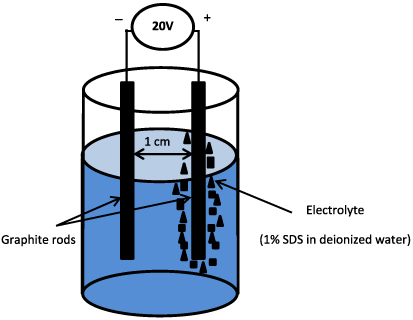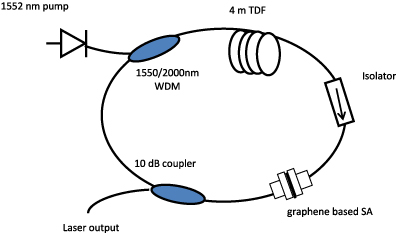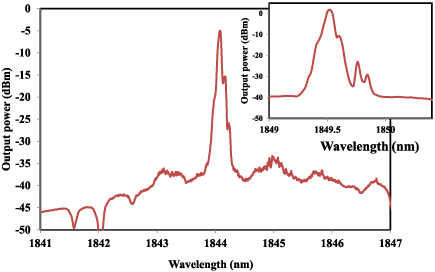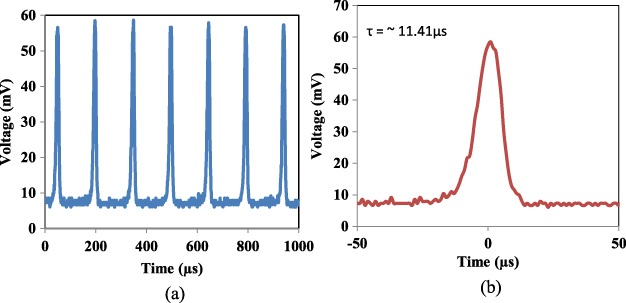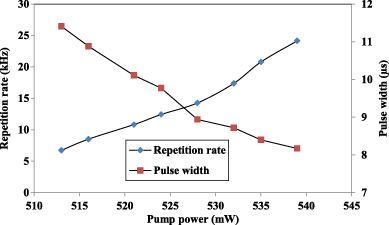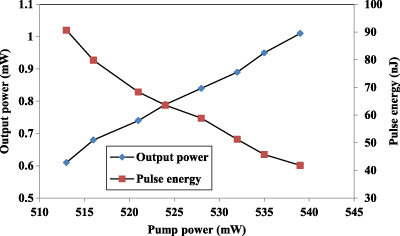Abstract
We demonstrate a simple, compact and low cost Q-switched thulium-doped fiber laser (TDFL) operating at 1844.1 nm by exploiting a graphene based saturable absorber (SA) in conjunction with 1552 nm pumping. The SA is fabricated by sandwiching the graphene thin film between two fiber connectors. The thin film was produced by mixing graphene flakes, synthesized by an electrochemical exfoliation process, with polyethylene oxide (PEO) solution. The TDFL generates a stable pulse train with 6.73 kHz repetition rate, 11.41 μs pulse width and 90.64 nJ pulse energy at 513 mW 1552 nm pump power. A higher performance Q-switched TDFL is expected to be achieved with the optimization of the SA and laser cavity.
Export citation and abstract BibTeX RIS
1. Introduction
Q-switched fiber lasers are of great interest because of their many applications in remote sensing, range finding, medicine, material processing, and telecommunications [1, 2]. They can be obtained through active [3] or passive techniques [4]. Compared to the ones derived via active techniques, passively Q-switched fiber lasers possess attractive advantages of compactness, simplicity, and flexibility in design. They have been extensively investigated using various saturable absorbers such as semiconductor saturable absorber mirrors (SESAMs) [5], and carbon nanotubes (CNTs) [6, 7]. However, the fabrication of SESAMs requires very complex and costly processes. CNT based saturable absorbers (SAs) are comparatively simple and more cost effective. Unfortunately, to operate at a particular wavelength, CNTs require bandgap tuning by controlling their diameters and chirality. Moreover, the surface tension of CNTs is too large, leading to a low damage threshold [8].
More recently, novel nano-material graphene has attracted much attention as it was reportedly used in broadband functional SAs [9]. This is due to the gapless linear dispersion of Dirac electrons in graphene which allows a broadband operation covering the wavelength range from the visible to the mid-IR. Compared with CNTs, graphene is expected to have a higher damage threshold due to its two-dimensional structure [10]. However, until now most reported works on graphene have focused on mode-locked fiber lasers [10–13] while graphene Q-switched fiber lasers were seldom [14–17] investigated. Recent realizations on Q-switched fiber lasers are mainly on the erbium-doped fiber lasers operating in the 1.5 μm region [18–20]. For instance, Luo et al [18] have recently reported a Q-switched erbium-doped fiber laser (EDFL) using an optical deposition technique.
Thulium-doped fiber lasers (TDFL) operating in the 'eye-safe' wavelength region are useful for various applications, for example in light detection and ranging (LiDAR), differential absorption LiDAR, and as pumps for mid-IR generation. So far, only a few works on the generation of Q-switched fiber lasers near the 2 μm wavelength region have been reported. For instance, Wang et al [21] reported a Q-switched generation with a maximum pulse energy of 69 nJ and a repetition rate of 26 kHz using a 1560 nm CW laser source and a graphene based SA. More recently, Jiang et al [22] achieved a laser with a short pulse duration of 760 ns and a repetition rate of 202 kHz using graphene transferred to the highly reflective mirror as the SA. In this paper, a Q-switched TDFL operating near the 1900 nm region is demonstrated using a simple and low cost graphene based SA. The graphene is synthesized by electrochemical exfoliation of graphite at room temperature in 1% sodium dodecyl sulfate (SDS) aqueous solution. Graphene flakes obtained from the process are mixed with polyethylene oxide (PEO) as the host polymer to produce free standing composite thin film which acts as a passive Q-switcher in the TDFL ring cavity. The SA is integrated in the TDFL by sandwiching the graphene thin film between two fiber connectors, resulting in a stable pulse train with 6.73 kHz repetition rate, 11.41 μs pulse width and 90.64 nJ pulse energy at 513 mW 1552 nm pump power.
2. Experiment
Figure 1 shows the experimental setup used for producing graphene flakes from the electrochemical exfoliation process. As shown in the figure, a constant voltage difference of 20 V was applied to two graphite rod electrodes, which were placed 1 cm apart in an electrolysis cell filled with electrolyte (1% SDS in deionized water) to generate hydroxyl and oxygen radicals. The oxygen radicals corrode the graphite anode and thus create black sediments (graphene) in the solution due to the intercalation of anionic surfactant. It was observed that graphene sheets started to peel off from the anode after several minutes. The exfoliation process was continued for 2 h to obtain a stable graphene suspension in the SDS solution. The stable graphene suspension was centrifuged at 3000 rpm for 30 min to remove large agglomerates. Then, the supernatant portion of the suspension was decanted. The concentration of the centrifuged graphene was estimated from the weight of the suspension used. To prepare the PEO solution, 1 g of polyethylene oxide (PEO) (Mw = 1000 000 g mol−1) was dissolved in 120 ml of deionized water. 5 ml of the graphene suspension was then mixed with 5 ml of the PEO solution to produce a polymer composite. The composite solution was dried in petri dishes at 56 ° C to obtain a graphene/PEO thin film with 50 μm thickness.
Figure 1. Electrochemical exfoliation of the graphene.
Download figure:
Standard image High-resolution imageFigure 2 shows the experimental setup of the proposed Q-switched TDFL using the fabricated graphene/PEO thin film as a passive Q-switcher. It consists of a 4 m long thulium-doped fiber (TDF), which is pumped by a 1552 nm laser via a 1550/2000 nm wavelength division multiplexer (WDM), an isolator, a graphene film based SA, and a 10 dB output coupler in a ring configuration. The SA is fabricated by using a tiny patch of the prepared film (2 × 2 mm2) and sandwiching it between two FC/PC fiber connectors, after depositing index-matching gel onto the fiber ends. The insertion loss of the SA is measured to be around 3.5 dB at 1900 nm. The TDF used has core and cladding diameters of 9 μm and 125 μm respectively and Tm ion absorption of 27 dB m−1 at 793 nm. The high absorption allows the use of a short active gain medium. An isolator is used to ensure a unidirectional operation of the laser. The laser output is obtained via a 10 dB optical coupler located after the graphene based SA, which channels out about 10% of the oscillating light from the ring cavity. The optical spectrum analyser (OSA, Yokogawa, AQ6370B) is used for the spectral analysis of the Q-switched EDFL with a spectral resolution of 0.02 nm, whereas the oscilloscope (OSC, Tektronix, TDS 3052C) is used to observe the output pulse train of the Q-switched operation via a 460 kHz bandwidth photo-detector (Thor lab, PDA50B-EC). The total cavity length of the ring resonator is measured to be around 13.6 m.
Figure 2. Experimental setup of the proposed graphene based Q-switched TDFL.
Download figure:
Standard image High-resolution image3. Results and discussion
Raman spectroscopy was performed to confirm the presence of a graphene layer in the fabricated graphene thin film and the result is shown in figure 3. In the experiment, a 532 nm light source was used in conjunction with a charge-coupled device (CCD) camera as a detector with an exposure time of 10 s. As seen in figure 3, three prominent peaks are observed at approximately 1351 cm−1,1617 cm−1 and 2911 cm−1, which are normally referred to as the D, G and 2D bands, respectively. The G band contributes to an E2g mode of graphite and is related to the in-plane vibration of sp2-bonded carbon atoms, while the D band is associated with the vibrations of carbon atoms with sp3 electronic configuration of disordered graphite. The intensity ratio of the D and G bands of the graphene sheets is about 1.2, indicating the presence of defects in the graphene samples. The 2D Raman peaks change in shape, position and relative intensity with the number of graphene layers applied. The Raman spectroscopy reveals a broad 2D peak, which indicates the graphene has a multi-layer structure. In addition, we obtained a G/2D peak ratio of slightly larger than 2, which further confirmed that we had multi-layer graphene on the fabricated thin film.
Figure 3. Raman spectrum obtained by 532 nm laser excitation on the graphene thin film, which indicates that the graphene has a multi-layer structure.
Download figure:
Standard image High-resolution imageFigure 4 shows the output spectrum of the Q-switched laser analyzed by an OSA with a resolution of 0.05 nm. In the absence of the SA in the cavity, the TDFL generates a CW laser as the pump power is set above the threshold value of 416 mW. The inset of figure 4 shows the output spectrum of the CW laser at the pump power of 416 mW, which operates at 1849.5 nm. Once the SA is inserted in the laser cavity, the laser starts to operate in a passive Q-switching operation as the pump power is adjusted to 513 mW. The pump threshold is relatively low compared to that of an SWNT or SESAM based Q-switched TDFL, mainly owing to a lower saturation intensity of the graphene. As seen in figure 4, the laser operates at wavelength 1844.1 nm with the full-width at half maximum of 0.05 nm limited by the OSA resolution and signal to noise ratio of about 29 dB. The threshold value is slightly higher and the operating wavelength shifts to a shorter wavelength by the incorporation of the SA due to the insertion loss of the SA. As the cavity loss increases, the oscillating laser shifts toward the peak absorption wavelength of the thulium fiber, which is near to 1800 nm to acquire more gain so that it can compensate the additional cavity loss.
Figure 4. Output spectrum of the Q-switched laser.
Download figure:
Standard image High-resolution imageFigure 5(a) shows the oscilloscope trace of the Q-switched pulse train when the pump power is fixed at the threshold value of 513 mW. There is no distinct amplitude modulation in each Q-switched envelope of the spectrum, which means that the self-mode locking effect on the Q-switching is weak. At 513 mW pump power, a stable passively Q-switching operation starts to occur with an average output power of 0.61 mW and a repetition rate of 6.73 kHz. The pulse energy is calculated to be around 90.64 nJ at this pump power. The pulse energy could be improved by reducing the insertion loss of the saturable absorber or by optimizing the laser cavity. Figure 5(b) shows the typical oscilloscope trace of the pulse envelope at the pump power of 513 mW. As seen in the figure, the full-width at half maximum or pulse width was obtained at 11.41 μs. Figure 6 shows the repetition rate and pulse width versus the pump power. Unlike a mode-locked fiber laser, where the repetition rate is dependent on cavity length, the repetition rate in a Q-switched fiber laser varies with pump power. As the pump power increases, more gain is provided to saturate the SA. Since pulse generation relies on saturation, the repetition rate increases with the pump power as shown in figure 6. When the pump power is tuned from 513 to 539 mW, the pulse train repetition rate varies from 6.73 to 24.16 kHz. On the other hand, the pulse width varies from 8.17 to 11.41 μs within the same pump power range. Further reduction in pulse width is expected when pump power increases to the point allowable by the damage threshold of the graphene based SA. A shorter cavity length using a higher dopant fiber would be an effective alternative for an even shorter pulse [23].
Figure 5. (a) The pulse train for the proposed TDFL with multi-layer graphene film based SA at threshold with the repetition rate of 6.73 kHz. (b) Enlarged pulse width spectrum with pulse width of 11.41 μs.
Download figure:
Standard image High-resolution imageFigure 6. Repetition rate and pulse width as a function of pump power.
Download figure:
Standard image High-resolution imageFigure 7 shows the average output power and pulse energy of the Q-switched TDFL as functions of pump power. The output power increases from 0.61 to 1.01 mW as the pump power is varied from 513 to 539 mW. On the other hand, the pulse energy reduces from 90.64 to 41.8 nJ as the pump power is increased within the same pump power range. These results indicate that graphene has great potential for superior Q-switching and saturable absorption compared to conventional light absorbing components when carefully employed in an appropriate laser system. The fabrication of the SA is also simple and thus the cost of the laser should be low. The simple and low cost laser is suitable for applications in metrology, environmental sensing and biomedical diagnostics.
Figure 7. Output power and pulse energy versus pump power.
Download figure:
Standard image High-resolution image4. Conclusion
A new all-fiber Q-switched ring TDFL is demonstrated based on 1552 nm pumping by employing a passive graphene thin film based SA. The graphene is fabricated via electrochemical exfoliation of graphite rod in electrolyte at room temperature and then mixed with polymer to form a free standing film with a thickness of 50 μm. The thin film is then attached to the end of a fiber ferrule with the aid of index-matching gel and connected with another clean fiber ferrule via an FC connector. The Q-switched TDFL has a threshold pump power of 513 mW with pulse-repetition-rate-tunable range of 6.73–24.16 kHz, and minimum pulse duration from 8.17 μs. The TDFL operates at around 1844.1 nm with an average output of 0.61 mW and maximum pulse energy of 90.64 nJ at the pump power of 513 mW. The proposed laser is expected to have many practical applications in fiber communications and sensors.
Acknowledgments
This project was funded by the Ministry of Higher Education under PRGS (Grant No. PR003-2011A) and HIRG (Grant No: UM.C/625/1/HIR/MOHE/SCI/29). B A Hamida would like to thank the International Islamic University of Malaysia for the postdoctoral fellowship.


